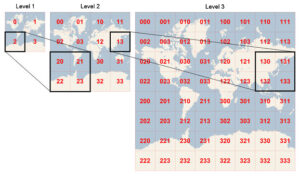Map tiles might seem like a good idea for displaying maps, but they come with some big drawbacks that make them less than ideal, especially when dealing with a lot of data or needing real-time information.
- Hard to Scale: For map tiles to work at different zoom levels, you need to create a new set of tiles for each level. Because the number of tiles increases fourfold with each additional zoom level, storing and managing all these tiles quickly becomes overwhelming and hard to keep up with.
- Lack of Flexibility: Map tiles are basically snapshots of map data at a certain time. Once a tile is made, it doesn’t change—even if the actual data it represents does. To update the map, you have to make new tiles for every affected zoom level, which is so tedious that most systems just update their tiles all at once every so often (like nightly or weekly), leading to outdated maps.
- Not Suitable for Real-Time Data: Due to their static nature, map tiles can’t show real-time changes in data. Updating tiles to reflect real-time data is impractical, making it hard to use map tiles for applications that need the most current information.
- Impossible to Change Themes: If you want your map to have different looks or themes, you need a separate set of tiles for each theme. This makes it even more difficult to manage and store all the necessary tiles.
- High Hardware Requirements: The process of generating, updating, and serving map tiles requires significant computational power and storage capacity. Organizations must invest in powerful hardware to efficiently manage the tile generation and storage process, adding to the cost and complexity of using map tiles.
- Impractical for Offline Use: Using map tiles on devices in offline mode is highly impractical. The vast number of tiles required for detailed and multi-level mapping makes it challenging to store them locally on a device, limiting their usefulness in scenarios without internet access.

Conclusion:
Using map tiles, especially the bitmap kind, can create more problems than they solve. They make scaling up hard, aren’t flexible, can’t handle real-time data, and complicate having multiple themes. As a result, organizations might need to invest in better technology to work around these issues, suggesting that looking for other mapping solutions (Cliffhanger Solutions’ Atlas, wink wink) is a far better approach.

